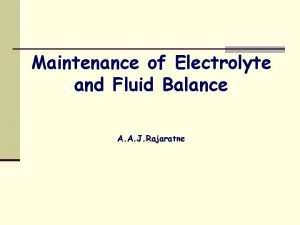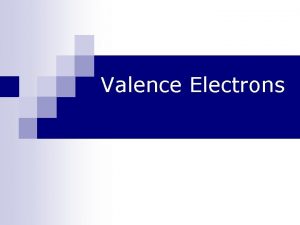Electrons Circulating a Nucleus Valence electrons are the



- Slides: 3

Electrons Circulating a Nucleus • Valence electrons are the electrons contained in the outermost, or valence, electron shell of an atom. Valence electrons are important in determining how an element reacts chemically with other elements: Neutrons Inert Gases HE=Helium NE=Neon Ar=Argon Kr=Krypton Don’t Interact Protons Good Conductors Thus the maximum number of electrons that each of the first four shells can hold Is: K = 2*(12 ) = 2 L = 2*(22 ) = 8 N = 2*(32 ) = 18 N = 2*(42 ) = 32 IB and IIB AG=Silver 47 AU= gold atomic #79 CD=Cadmium #48 CU=Copper #29 HG=Mercury ZN=Zinc #30 @Copyright David Lubliner NJIT 2007 RG=roentgen #111

Animation of Electrons Moving Through A wire (yellow wire) -1 -1 -1 atom atom -1 -1 atom No net gain in electrons (one enters the wire (in yellow) knocks the other out of its valence shell and takes its place) atom -1 -1 atom + Lets Say each atom has 5 Electrons and 5 Protons with a net charge • (+5 and -5)= 0 Atoms with • (+5 and -4)=+1 (extra proton) • (+5 and -6)= -1 (extra electron) • Maximum Speed electromagnetic energy -1 -1 -1 Atoms need electrons Battery More Protons More electrons can travel through empty space is the speed of light 186, 000 miles per second. • Average speed electrons flow through a wire 100, 000 miles per second. • Speed electrons flow through human nerves 100 feet per second. @Copyright David Lubliner NJIT 2007

Quantum Mechanics (Photons generated) • The word “quantum” (Latin, “how much”) in quantum mechanics refers to a discrete unit that quantum theory assigns to certain physical quantities, such as the energy of an atom at rest (see Figure 1, at right). The discovery that waves have discrete energy packets (called quanta) that behave in a manner similar to particles led to the branch of physics that deals with atomic and subatomic systems Energy imparted to atom, electron moves to next shell When electron return to previous shell it gives off one PHOTON (packet) of energy Neutrons Protons • In empty space, the photon moves at c (the speed of light 186, 000 miles/sec) and its energy E and momentum P are related by E+c. P. • The photon is the elementary particle responsible for electromagnetic phenomena. It is the carrier of electromagnetic radiation of all wavelengths, including gamma rays, Xrays, ultraviolet light, visible light, , infrared light, microwaves, and radio waves. The photon differs from many other elementary particles, such as the electron and the quark, in that it has zero rest mass @Copyright David Lubliner NJIT 2007





